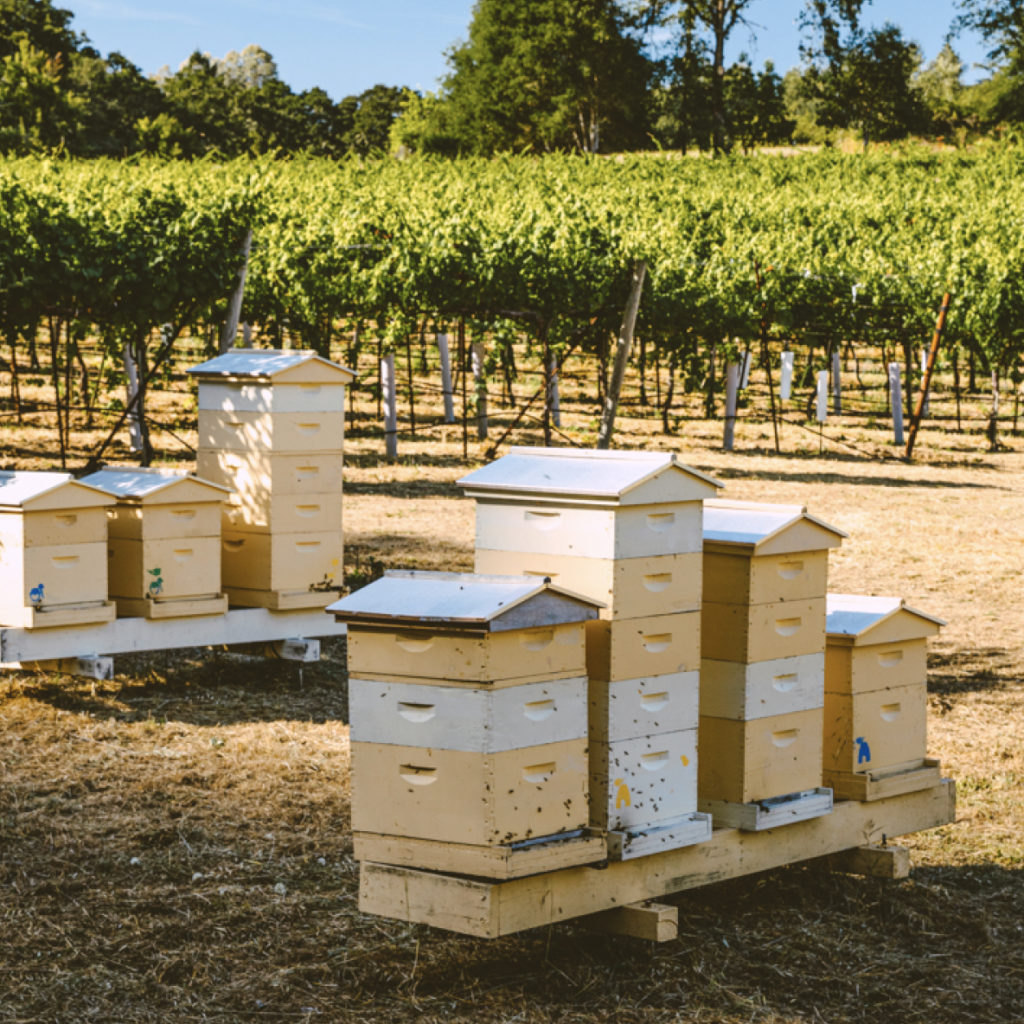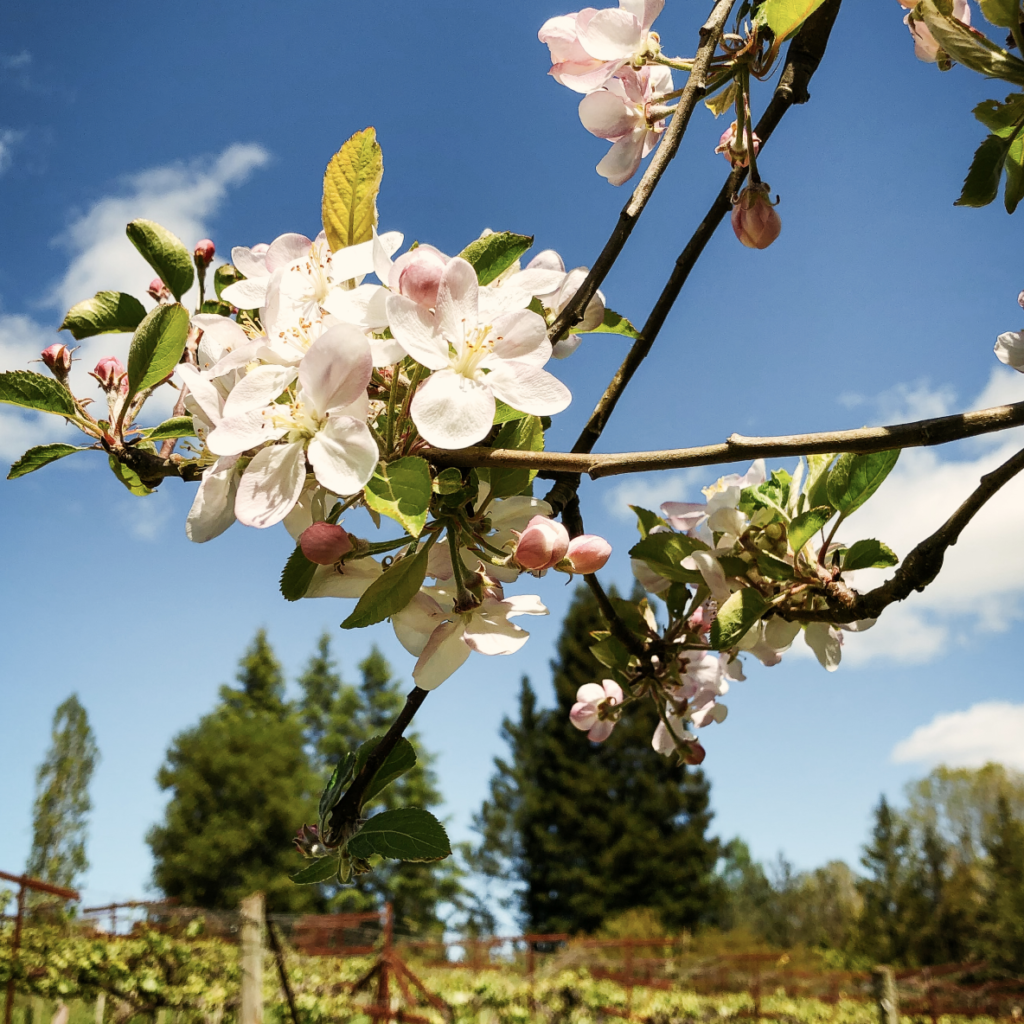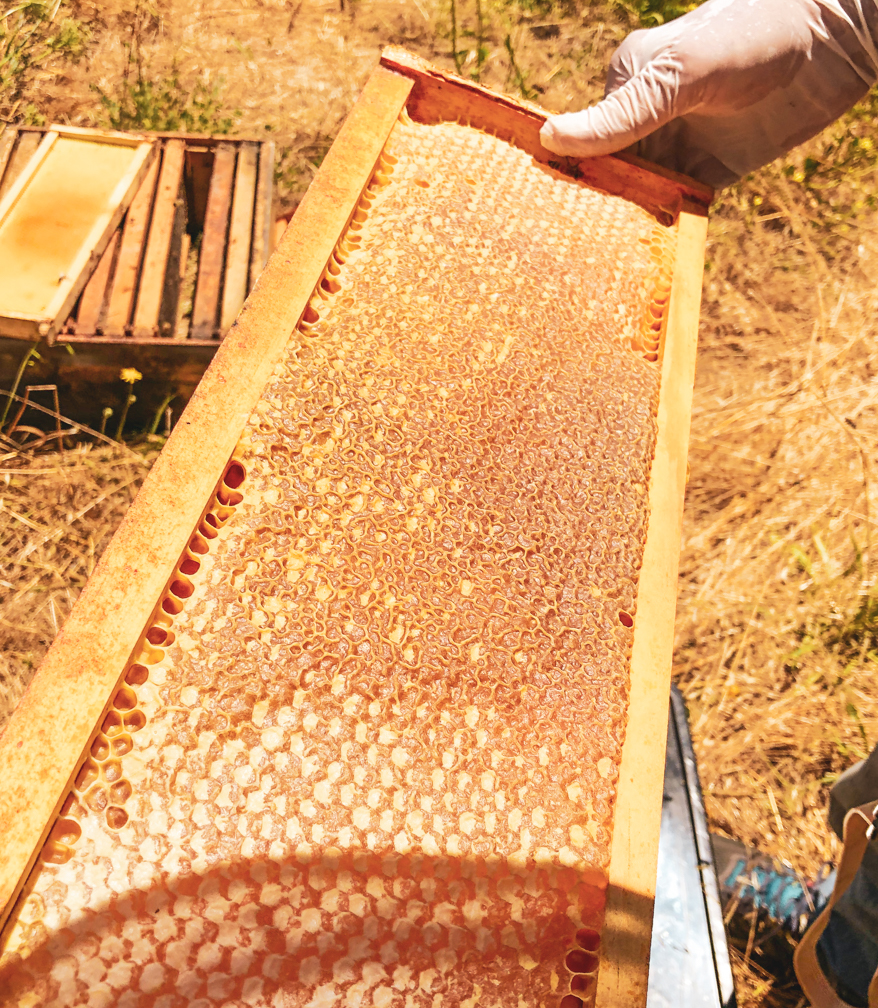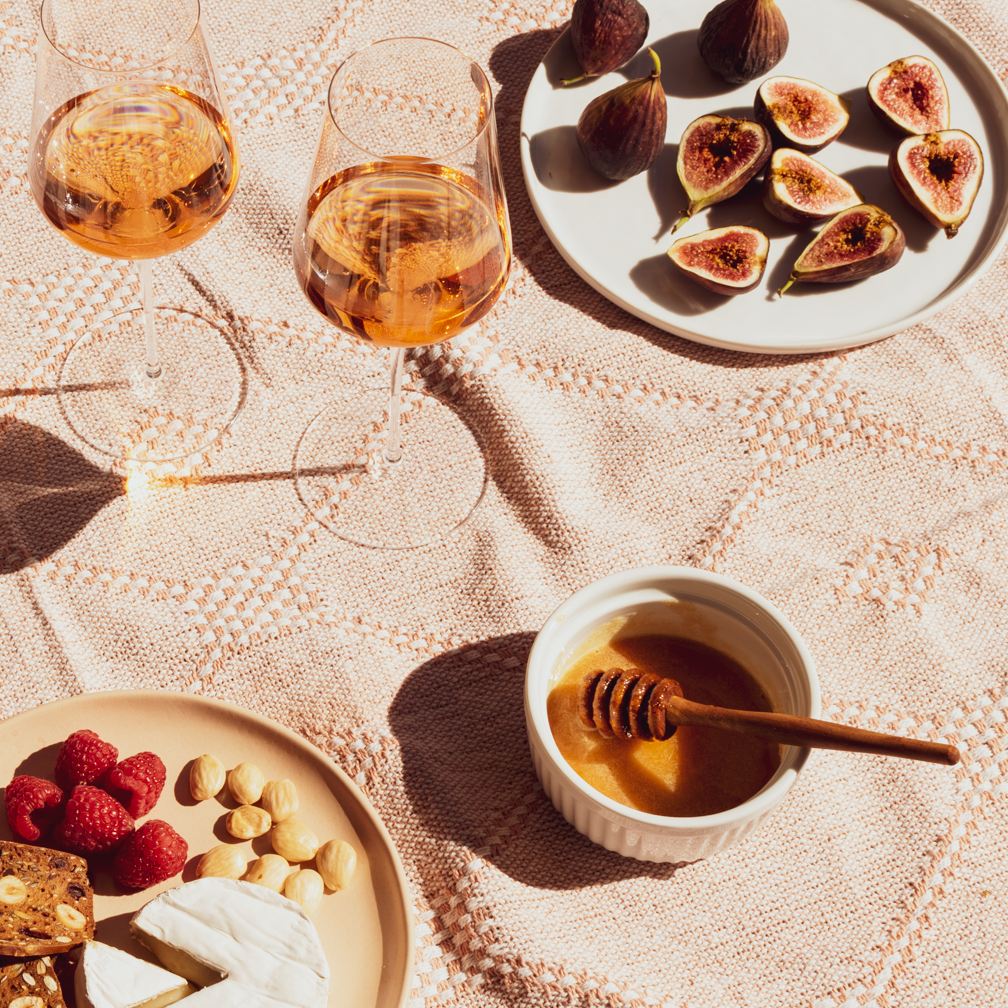The power of our Russian River Bees
White wooden boxes are nondescript places for superheroes to live, but they are there. Millions live among us, faithfully performing almost magical tasks that affect the lives of countless living things. Who are these superheroes? Honeybees. Their work as pollinators contributes to the production of flowering plants everywhere. Without them, both our quantity and quality of food would be negatively affected.
Why Have Bees?
Tobias Glen Vineyard is proud to include bee colonies as part of our property’s thriving ecosystem. They are expertly managed by Bonnie Bee & Company, headed by Bonnie Morse (a.k.a. Bonnie Bee). Under Bonnie’s leadership, our colony has thrived and doubled.
Here’s how everything works together: bees pollinate our cover crops, while those cover crops provide nectar and pollen for bees. Our grapevines benefit from this bee relationship, too. Cover crops are planted near the vines (and are pollinated by the bees) and the crops help to maintain our soil’s health and water-holding capacity, eliminate the need for chemicals, and regulate vine growth.
Read on to gain an understanding about the fascinating life of the honeybee, and to learn about their role in creating honey at Tobias Glen.

What Do They Pollinate?
Honeybees are responsible for pollinating flowering plants. This includes fruits like apples, cherries, blueberries, and strawberries, plus other types of flowering plants such as almonds, cocoa beans, and coffee beans. In fact, around 75% of native plants require animal pollination, and most of this is through bees.
In Tobias Glen, there are currently 10 colonies of bees, which is what the surrounding area can support in terms of forage. Our Russian River Bees are placed in an area where they don’t disturb vineyard work and where they get maximum sun during winter months.
Did you know?
Some crops, including blueberries and cherries, are 90% dependent on pollination by honey bees. And almond crops depend entirely on honey bees for pollination at bloom time. Honeybees indirectly contribute to meat production too, as they pollinate plants such as alfalfa, which are then eaten by livestock and consumed by humans.
Let’s take a look at their amazing collaboration to create honey.
Foragers Head Out
When a female worker bee becomes about 20 days old, she is old enough to venture out as a forager to look for nectar and pollen. Bees at Tobias Glen can visit the flowers of Gravenstein apples, olallie berries, cherry plums, heirloom roses, and annual cover crops such as peas, oats, and clover.
If you’re curious about additional jobs that worker bees do, and would like to know more about the colony’s two other groups drones (male honeybees) and the queen, please visit here.)
Foragers leave the hive at sunrise. They can visit flowers up to five miles from the hive, making up to 10 trips a day and returning to the hive at sunset. Workers typically live around six weeks in the summer and will frequently die in the field while foraging.
Did you know?
On each foraging trip, bees will only visit one type of flower. They’ll visit many individual flowers, but only of one type. For the flowers, this provides pollination without crossing species. During one foraging trip, a single honeybee visits between 50 to 100 flowers. And according to Morse, in order to create one pound of honey, the bees must visit two million flowers!

So, What Exactly Are They Doing?
As bees fly from flower to flower, they move pollen from plant to plant on their legs, and this is how pollination occurs. When a bee collects nectar and pollen from the flower of a plant, some pollen from the stamens—the male reproductive organ of the flower—sticks to the hairs of her body. When she visits the next flower, some of this pollen is rubbed off onto the stigma, or tip of the pistil—the female reproductive organ of the flower. When this happens, fertilization is possible, and a fruit, carrying seeds, can develop.
Did you know?
Plants will respond if pollinated by more than one bee. Pollination expert Barbara Gemmill-Herren notes, “Part of the biology of plants, which is interesting, is that they will put more effort into making a really nice fruit or vegetable the more it’s pollinated. As a result, those items tend to pack more nutrition thanks to a higher frequency of insect visits.”
What Happens to the Pollen and Nectar?
As for pollen, bees don’t just transport it between plants, they also bring it back to the hive as food. Certain honeybees have little pellets or “saddlebags” of pollen on their legs. Long hairs on the bees’ legs help to hold the pollen in place. Once back to the hive, the workers remove the pollen themselves and stuff it into cells with their heads. The pollen is mixed with nectar and bee mouth secretions, forming “bee bread” and placed at the perimeter of the brood nest, forming a ring. Bee bread is the main food source for honey bee larvae and workers.
Nectar is Processed
At Tobias Glen, maximum nectar is usually available from February to May. When bees collect nectar from flowers, they store it in their honey stomach, also known as the crop. When the bee returns to the hive, it regurgitates the nectar from its honey crop into a processor bee’s mouth. The processor bee stores the nectar in its honey crop and regurgitates it to a bee that’s closer to the honeycomb for storage.
After nectar is collected, the worker bees place it into wax cells and leave it uncapped. This allows for the water content of the nectar to be reduced. Bees help this process along by fanning their wings over the cells, and passing air over the nectar.
Just Right
Bees will cap the honey, or cover it with a thin layer of wax, when the water content of the nectar has been reduced to the correct point. The wax cap ensures that the honey will maintain its water content.
Extracting Honey
When the time is right, wax cappings are removed from the honey frames, and the honey is spun out by centrifugal force in an extractor. Summer and fall are usually when conditions are favorable. Because bees don’t forage on grape vines, honey production will be limited in an area like Tobias Glen. Bonnie Morse notes that, “Last season, we extracted 20 lbs in July and 95 lbs in October. That was from 9 colonies, so each was only able to produce an excess of approximately 13 lbs. It really depends on the season, temperatures, rain cycles, etc.” And honey always needs to be left behind for bees to use throughout the winter. A full-sized colony at Tobias Glen needs about 30 lbs of honey for winter, for example.
Raw, Delicious Honey
No heat or filtering is used in our extraction or bottling processes for Russian River Bee raw honey. Honey flavors are influenced by the seasons and the surrounding flora. Springtime brings floral notes from trees and perennials in bloom. Later in the season, hints of apple, pear, and wild berries are detected as nearby fruits begin to ripen. To enjoy your own 10 oz bottle, visit our web store.
The raw honey is a phytonutrient powerhouse, and is often prized for its antioxidant, antibacterial, and antifungal properties. Those who suffer from seasonal allergies are often encouraged to consume honey from their local area, in order to ingest small amounts of flower pollen, and hopefully build an immunity against the offending allergens. The jury is still out on whether or not consuming honey is beneficial for allergies, but some swear by it. Always be sure to consult with your doctor before beginning any treatment for allergies, including eating honey.
Ending Thoughts
Bees have a remarkable role in the success of so many crops, but what happens when they just aren’t around? In many areas, the native environment lacks enough bees to pollinate the crops, so they are brought in to get the job done. In 2017, for example, beekeepers in North Dakota, Idaho, Florida, and other states shipped 1.7 million bee colonies to pollinate California almond trees. While the bees are crucial to the almond trees, utilizing bees in this way can relegate the insects to a restrictive diet of a single item. Bees need more than one food source, and, as with humans, dietary deficiencies weaken the immune system, making bees more susceptible to illnesses and death. So, while the out-of-state bees are brought in for the seemingly positive task of pollination, this can risk the lives of the colonies. It’s important to consider the ramifications of shipping bees to provide a singular service and how this practice might impact bee health and possible loss. Key questions need to be tackled – namely, how can we increase the bee population across the United States? Ensuring a world that has enough bees is crucial.
References
Many thanks to Janie Woo and Bonnie Morse for contributing information for this blog post.


